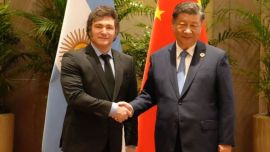Argentina’s hodge podge exchange rate regime is running out of steam.
With restrictions for Argentines to buy dollars at the official rate, many are turning to the black market where the cost to buy greenbacks with devalued pesos is rising by the day.
In the past day alone, the rate informal currency traders are quoting buyers in downtown Buenos Aires jumped more than four percent to 164 pesos per dollar. On official exchange house boards and the Central Bank website the peso was largely unchanged in that period at 77.14 per dollar. That’s a difference of 112 percent.
Not since 1989, when the gap hit 215 percent, has Argentina seen a difference so great among its multiple exchange rates, according to the book Historia Economica de la Argentina, by Domingo and Sonia Cavallo.
The gap between the two rates – along with an array of other “parallel exchange rates” derived from financial transactions – has gapped out to a record this week.
On top of tighter capital controls, the Central Bank’s vow to “add more volatility” to the currency market (i.e. quicken the pace of devaluation as part of its crawling peg) has yet to materialise. And temporary tax breaks for farmers haven’t slowed a drop in international reserves.
The Central Bank also adjusted some interest rates late Thursday in an attempt to bring two key rates closer together.
"The government still hasn’t taken substantive measures aimed at reducing the fiscal deficit and financing through money printing,” Adrian Yarde Buller, chief economist at SBS Group, said in a telephone interview.
The government has also tried to reduce the exchange rate gap through intervention in the local bond market using the fund manager arm of state pension agency ANSES to little avail.
Since the tighter capital controls announced September 15 that increased taxes on dollar purchases, the black market rate – known locally as the “blue” – has already tumbled 11.5 percent.
related news
by Ignacio Olivera Doll, Bloomberg























Comments